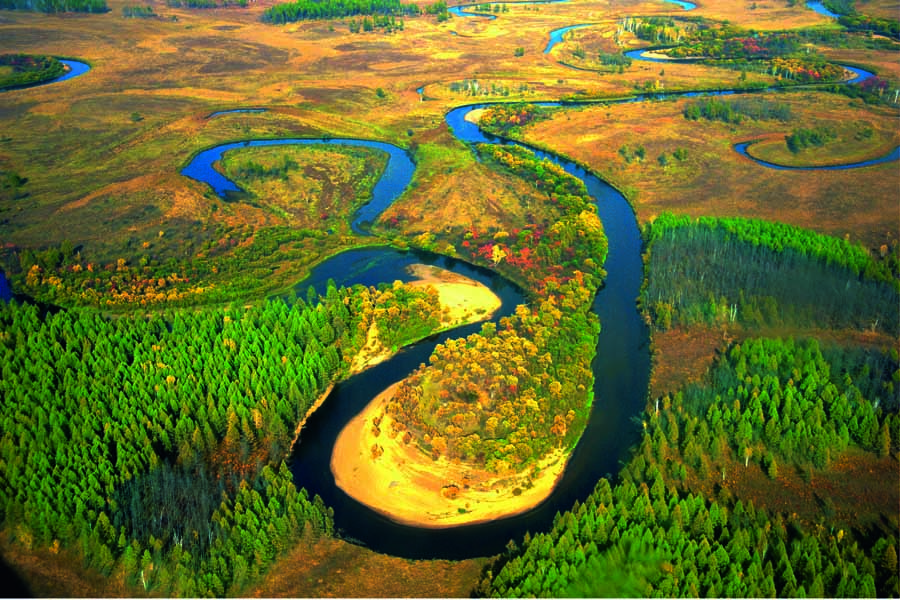Transformation of the Greater Khingan Range Region

Nestled in the northwestern part of Heilongjiang Province in northeastern China, the Greater Khingan Range is an important state-owned natural forest region that serves as a biological protective screen for northeastern and northern China. Since 1964, the Greater Khingan Range has provided much of the timber that supported the country’s economic development, which led to a dramatic drop in its forest resources.
To restore the environment, commercial logging was banned in the Greater Khingan Range on April 1, 2014, which resulted in 30,000 woodcutters losing their jobs. In a move aimed to enable the people inhabiting the area to continue making a living, administrators of the Greater Khingan Range are working to transform its economic structure while protecting the environment.

Erlang Mountain is famous for winter scenery and Taoist culture. by Chen Decheng
Source of Income under Tree
“The Greater Khingan Range covers 83,000 square kilometers, about 10,000 of which grows wild blueberry,” beams Tian Fuhe, head of Amuer Blueberry Plantation. “Its output accounts for 90 percent of the nation’s total and Amuer accounts for as much as 25.4 percent.”

Beihong Village, one of the northernmost villages in China. by Lou Yu
The Greater Khingan Range features coniferous forests growing in acidic soil and a wide difference in day and night temperatures, conditions agreeable for blueberries. “The sun rises at 3 a.m. and sets at 9 p.m. The fact that this resource is caused by the climate gives us a sort of monopoly. Our blueberry is uniquely delicious.”
Located in the northern part of the Greater Khingan Range, the Amuer Forestry Bureau is considered the “home of wild blueberries in China.” During harvest season, locals wake up at 3 a.m. and take motorcycles up the mountain to collect blueberries. Picking wild blueberries becomes more difficult and dangerous as available plants are harder to find, according to Tian Fuhe. Because of this, the Amuer Forestry Bureau founded the Amuer Blueberry Plantation seven years ago to breed blueberry seedlings and train technicians. Today, the plantation covers 10.1 hectares and grows 1.2 million seedlings. All the blueberry fields under the administration of the bureau now cover 40 hectares. Along with plantations, the bureau also succeeded in attracting investment to build the Arctic Ice Blueberry Chateau and a Blueberry Town, which attract many tourists each year.
Actually, Amuer is not the only place in the area developing the blueberry industry, which has widely become a primary source of income in the Greater Khingan Range. Over 160 blueberry products have been developed, ranging from blueberry juice, wine and dried fruit to healthcare products. Lingonberry Boreal Biotech Co., Ltd. has invented more than 30 products from extracts of blueberries and flora in the frigid zone. In March 2015, the company went public.
Today, the Greater Khingan Range’s reserve for wild blueberries has expanded to 7,450 hectares and its area of cultivated blueberries has reached 130 hectares. The production value of the blueberry industry measured 480 million yuan last year, making it the main source of income for locals. Meanwhile, others plant mushrooms such as black fungus and Hemlock varnish shelf in places that have been logged, which has also increased incomes.

Amuer Blueberry Plantation covers an area of 10.1 hectares and grows 1.2 million seedlings. by Zhang Chunxia
Sustainable Tourism
Known as “China’s north pole,” the Greater Khingan Range is the northernmost tip of China, where Russia can be reached by crossing a river. On the northern slope of the Greater Khingan Range, Beiji (literally, “North Pole”) Village is the country’s northernmost village and has the best spots to see the northern lights. Many visit the village seeking China’s northernmost amenities and structures and its snowy and icy scenery in winter.
At the entrance of the village is a family hotel owned by a local couple who used to be farmers. In 2007, they renovated their house into a family hotel. In order to accommodate more tourists, they later expanded the house so they could offer six rooms instead of four. The business earns tens of thousands yuan a year and has become the main source of income for the family.
“Villagers used to subsist on farming and forestry,” explains Li Xueming, head of Beiji Township. “Their average income was less than 10,000 yuan a year. Thanks to the development of tourism, over 140 of the 680 households in the village operate family hotels and the per capita income in the village increased to 21,000 yuan last year.” In peak season, they welcome as many as 3,000 tourists a day.

Qianshao Forestry Bureau has set up a breeding center that has raised more than 70 deer and 110 forest hogs. by Zhang Chunxia
The Greater Khingan Range has rich tourism resources including forests, snow and ice scenery, stone forests, wetlands and prehistoric cliff paintings. Since 2014 when commercial logging stopped, the region has sprouted ecological tourism, which has been given top priority among the six primary industries amidst the region’s transformation.
“We have beautiful landscapes as well as snow and ice,” notes Jia Yumei, secretary of the Party Committee of the Greater Khingan Range Region. “Tourism, especially winter tourism, is key to our brand.” Hailed as one of the Top 20 Most Attractive Places in China, the Greater Khingan Range has become a new tourist hub in northern China. In 2015, the region received 4 million tourist trips and earned more than 4 billion yuan in tourism revenues. From January to August of 2016, the figure reached 3.548 million and 3.43 billion, up by 19.5 percent and 22 percent year on year respectively.
“As a tourist attraction, the Greater Khingan Range is highly dependent on nature, so we have to follow environmentally-friendly guidelines,” Jia emphasizes. “We have to carefully plan every development, strengthen environmental monitoring and protection and improve ecological capacity.”
